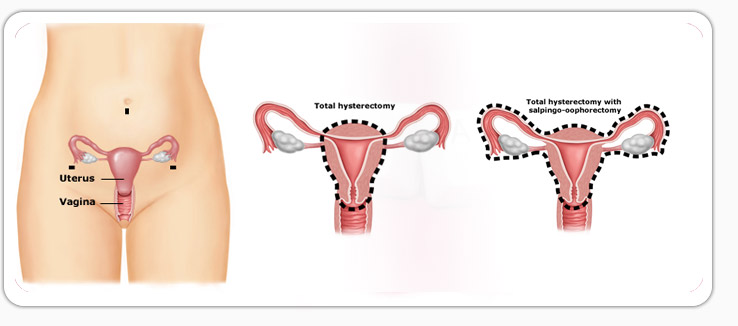
To treat certain complications of the uterus, your doctor may advise a procedure called laparoscopically assisted vaginal hysterectomy (LAVH). This is surgery to remove the uterus (womb). You may need this procedure because of severe pain or bleeding or a pelvic infection, which hasn’t responded to other treatments. Or, you may have cancer or another reproductive system problem. After hysterectomy procedure you can relieve from your symptoms. And if you have cancer, it can save your life. Your doctor recommends a type of surgery called laparoscopy. This method has many benefits compared to open surgery. These include faster recovery and less time in the hospital. This is an amazing advancement in the field of gynaecological surgery, now known as Minimal Invasive Surgery. Why wouldn’t most women not want this type of surgery if given the choice! Be sure and check with your laparoscopic surgeon to make sure he or she has had the proper training and the hospital has the appropriate equipment and training on hand. Technology can be wonderful and valuable for all concerned.
What Is Laparoscopy?
Laparoscopy is a type of surgery that is done with a long slender tool called a laparoscope. During surgery the scope is inserted through one of several small incisions. A light and a tiny video camera are attached at the end of the scope. These let the surgeon view the inside of the abdomen on a screen. Surgical tools are inserted through the other incisions. The surgeon may use robotic laparoscopy. This technique gives a three-dimensional view of the inside of the abdomen. And it assists the laparoscopic surgeon’s hand movements during the operation.
Benefits of Laparoscopic Hysterectomy:
Laparoscopy lets you avoid having a large incision in the abdomen. This “open” surgery is called abdominal hysterectomy. Compared to open surgery, laparoscopy may:
Problems Laparoscopic Hysterectomy Can Treat: Certain health problems can cause pain or bleeding in the uterus. These problems can sometimes be controlled with medication. Or, surgery that doesn’t involve removing the uterus may be an option. But, in some cases, the best way to relieve symptoms is to remove the uterus.
 Fibroids are lumps of muscle tissue that grow in or on the wall of the uterus. Fibroids are not cancer. A fibroid can cause pain and heavy bleeding. It may press on the bladder or rectum. This can lead to frequent urination, infections, and other problems.
Fibroids are lumps of muscle tissue that grow in or on the wall of the uterus. Fibroids are not cancer. A fibroid can cause pain and heavy bleeding. It may press on the bladder or rectum. This can lead to frequent urination, infections, and other problems.
Endometriosis is the growth of uterine lining outside of the uterine cavity. This tissue can lead to scarring (adhesions) throughout the pelvic cavity. This can cause severe pain and problems getting pregnant.
Adenomyosis is the growth of the endometrium into the uterine muscle. This can cause abnormal bleeding and severe menstrual cramps.
Uterine polyps are fleshy growths of tissue from the uterine wall. They can cause abnormal bleeding.
Your Medical Evaluation: –
Before suggesting a hysterectomy, your doctor will evaluate your health problem. He or she will ask questions about your past health and do an exam. Special tests and procedures may be done to help with your diagnosis. The results help you and your doctor plan your treatment.
Your Health History
Taking a health history helps your doctor learn more about your problem. He or she may ask about:
Your Physical Exam:
Your doctor will do a pelvic exam to check your reproductive organs. He or she looks for problems such as enlarged organs, lumps, or tender spots. A general exam will also be done. Blood may be taken to learn more about your health.
Tests and Procedures
Certain tests and procedures help diagnose your problem and plan your treatment. These may include:
You and your doctor will go over the results of your exams and tests. Together, you’ll make a treatment plan. Options for treatment may include medications, nonsurgical procedures, hysterectomy, or a combination of treatments. Questions to think about include:
Are there medications or other types of surgery that are likely to relieve your symptoms.
Is your health problem getting in the way of your daily life? Is the problem getting worse? If the answer to these questions is “no,” a hysterectomy may not be needed.
If you are in your childbearing years and wish to have children, take time to explore options that may help you avoid a hysterectomy.
If you’re at increased risk of ovarian cancer, your doctor may suggest removing the ovaries and fallopian tubes along with the uterus.
There is an array of surgical techniques used by the doctors for performing hysterectomies. Singla Mediclinic uses latest technology and procedures to carry out different hysterectomies performed by Dr. Raman Singla(laparoscopic Surgeon in Mohali) and Dr. Rimmi Singla(IVF Specialist & Consultant Laparoscopic Gynaecologist & Obstetrician).
Total abdominal hysterectomy:
It is the procedure where your uterus including the cervix is removed. Uterine fibroids, cancer of the ovary, and uterus are the main reason to use this surgical method.
Vaginal hysterectomy:
It is the procedure where the doctor removes the uterus through the vagina. This is a preferred surgical method for conditions like uterine prolapse, cystocele, rectocele.
Laparoscopy-assisted vaginal hysterectomy:
Laparoscopy hysterectomy is similar to vaginal hysterectomy where the doctor removes the uterus through the vagina, but it adds the use of a laparoscope.
Total Laparoscopic Hysterectomy – TLH:
Hystrerectomy is done totally laparoscopically and thus overcoming the limitations of vaginal procedure, like previous caesareans, large uterus, endometriosis, etc. The procedure mimics the same as abdominal procedure with all the advantages of laparoscopy, with a magnified, closer view.
Looking Toward the Future Deciding to have a hysterectomy can be hard. But most women who have this surgery are happy with the results. With relief from your symptoms, you’ll be better able to enjoy your life.
